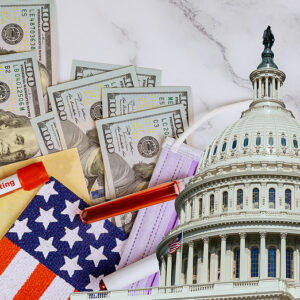With a $1.9 trillion stimulus package following the $900 billion COVID relief deal in December, which followed the $2 trillion stimulus package in March, the federal government will have pumped $4.8 trillion into the economy over just 11 months. Adjusted for inflation, that’s 20 percent more than the U.S. spent on the entirety of World War II.
While we can’t say what would have happened had the government not spent this gargantuan sum, we do know that, had the government divided that $4.8 trillion evenly among all but the richest 20 percent of households, each household would have received a check for almost $50,000.
The effects of spending that money would have been breathtaking. For the first time in history, a country would have entirely eradicated poverty. And not just that. We would have eliminated the entire lower class as the poorest U.S. households found themselves thrust into the middle-class overnight.
Yes, handing households $50,000 checks does no good if there are no businesses left from which to buy things. But, even if households had spent just a fraction of the $50,000, it would have been a boon to U.S. businesses. Instead, households received $1,200 checks, then months later $600 checks, and are now expecting around $1,400 more. The taxpayers footing the bill are left with the dregs.
But then, this is nothing new. The government has been wasting our time and money for decades on various wars against common nouns. The War on COVID is only the second most expensive of these wars. The most expensive – by far – is the War on Poverty which has cost $23 trillion with no end in sight.
Since the War on Poverty began in 1965, the U.S. poverty rate has been a pretty steady 10 percent (plus or minus 3 percent), trending neither up nor down. To look at the numbers, one might argue that we’re doing our best to fight a really strong enemy because, despite spending $23 trillion, we’re just managing to hold poverty at bay. But that brings us back to our earlier question: what would have happened if we had simply given that $23 trillion to the poor instead of constructing and feeding over one-hundred poverty programs for more than 50 years?
If the government had divided among the poorest 20 percent the $23 trillion it has spent fighting its War on Poverty, the U.S. poverty rate would have dropped to zero every year from 1965 through to the present. For the same $23 trillion, we could have eradicated poverty a half-century ago.
So, why does the federal government seem never to consider the option of replacing government assistance programs with direct payments? In the COVID crisis, and in the broader war against poverty, direct payments would have solved vexing problems as efficiently as possible.
And therein lies the rub. Politicians aren’t all that concerned with solving problems efficiently. They prefer to expand their power, which they do by creating more programs to “solve” problems that somehow never get solved. Not surprisingly, promises of more and larger programs also resonate with the entrenched, ever-growing federal bureaucracy and the swarm of private contractors for whom government programs are life’s blood.
In the end, the people receive pennies on the dollar compared to what they would have received had the government simply disbursed funds directly. But we all know this was never a possibility. Why?
Because it would have worked so well that we all would have seen how unnecessary complex government programs actually are.

